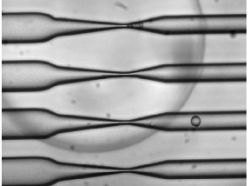 |
| These are channels through which cells are compressed.--Courtesy of Emily Jackson and Armon Sharei |
Getting drugs across the cell membrane is one of the fundamental obstacles facing drug delivery specialists. Researchers at MIT are working on a way to introduce compounds without the use of vectors such as viruses or proteins--instead, they're squeezing the cells, forcing them to open up.
By forcing cells through constricted microscopic channels that are 30% to 80% narrower than the cell itself, Armon Sharei and his team found that, after such a shock, holes form in the cell membrane for up to a minute, long enough to allow drugs to enter.
Immune cells and embryonic stem cells are among those compatible with the method, which, according to a paper Sharei and his team published in Proceedings of the National Academy of Sciences, produces a tenfold improvement in colony formation compared with traditional methods.
The mechanical, microfluidic approach can be used to deliver several macromolecules, including carbon nanotubes, proteins and siRNA, into the cells. The advantage of this technique, Sharei said in a NewScientist report, is that, without virus or protein carriers, there are potentially fewer side effects.
"We were working on a system where you basically shoot material into a cell, and we found that the deformed cells were an important part of that," Sharei told FierceDrugDelivery. "We're very excited about the clinical application, from stem cells to cancer therapies and other areas such as imaging."
The problem the scientists now have is being able to see the process in action--the cells travel at rates faster than even high-speed cameras can track.
- here's the PNAS paper
- and here's the NewScientist article with video
Editor's note: This article was updated to reflect comments from Armon Sharei.